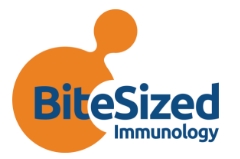BiteSized Immunology: Special Topics

Gut Microbiota and Obesity
Between 1,000 and 1,150 bacterial species have potential to colonise the human gastro-intestinal (GI) tract, with each individual harbouring around 160 different species (1). The composition of the gut microbiota has received attention as an etiological factor in the development of obesity. It is sensitive to dietary changes and able to alter composition within hours in both animals and humans (2-5). Independently of diet, the gut microbiota is able to influence host inflammatory responses.
The bacterial components of Gram-negative bacteria, such as lipopolysaccharide (LPS), trigger innate immune responses in the host which can lead to weight gain (6). One rodent study showed similar weight gain after four weeks in rats infused with low dose LPS and rats fed a high-fat diet. When CD14 -/- rats were infused with LPS, no weight gain occurred (7). In much the same way, Toll-like receptor (TLR) 4-deficient mice, which are unable to respond to LPS, are protected from high-fat diet-induced obesity and insulin resistance (8).
Many bacteria produce butyrate, including the Eubacterium rectale–Clostridium coccoides group and Faecalibacterium prausnitzii (9). Butyrate inhibits lymphocyte proliferation, interleukin (IL)-2 and interferon (IFN)-γ (10) – it is this anti-inflammatory action that explains butyrate’s therapeutic effects in inflammatory bowel disease (IBD) patients.
Some GI bacteria can suppress host Fasting-Induced Adiposity Factor (Fiaf) and tight junction proteins such as ZO-1 and occludin expressed in the intestinal epithelia. Fiaf plays a central role in triglyceride metabolism (10,11). This glycoprotein inhibits lipoprotein lipase production in adipose tissue and modulates fatty acid oxidation in both adipocytes and skeletal muscle (12). Suppression of tight junction proteins increases intestinal permeability (13).
Evidence suggests that the GI microbiota in the obese is different from the normal weight subject. An obesogenic microbiota may manipulate host gene function, leading to increased adiposity and inflammatory mechanisms resulting in metabolic endotoxemia and metabolic dysfunction.
References
1. Qin J, Li R, Raes J, Arumugam M, Burgdorf K, Manichanh C, et al. A human gut microbial gene catalogue established by metagenomic sequencing. Nature 2010;464:59.
2. Arumugam M, Raes J, Pelletier E, Le Paslier D, Yamada T, Mende D, et al. Enterotypes of the human gut microbiome. Nature 2011 12 May; 473:174-180.
3. Ley R, Turnbaugh P, Klein S, Gordon J. Microbial ecology: Human gut microbes associated with obesity. Nature 2006;444:1022-1023.
4. Schwiertz A, Taras D, Schäfer K, Beijer S, Bos N, Donus C, et al. Microbiota and SCFA in Lean and Overweight Healthy Subjects. Obesity 2009;18(1):190-195.
5. Wu G, Chen J, Hoffman C, Bittinger K, Chen Y, Keilbaugh S, et al. Linking long-term dietary patterns with gut microbial enterotypes. Science 2011;334:105.
6. Harris K, Kassis A, Geneviève M, Chieh C. Is the Gut Microbiota a New Factor Contributing to Obesity and Its Metabolic Disorders? Journal of Obesity 2012;2012:14.
7. Cani P, Amar J, M. A. Iglesias M, Poggi M, Knauf C, Bastelica D, et al. Metabolic endotoxemia initiates obesity and insulin resistance. Diabetes 2007;56(7):1761-1772.
8. Shi H, Kokoeva M, Inouye K, Tzameli I, Yin H, Flier J. TLR4 links innate immunity and fatty acid–induced insulin resistance. The Journal of Clinical Investigation 2006 11 November;116(11):3015-3025.
9. Balamurugan R, George G, Kabeerdoss J, Hepsiba J, Chandragunasekaran A, Ramakrishna B. Quantitative differences in intestinal Faecalibacterium prausnitzii in obese Indian children. Br J Nutr ;103(03):335-338.
10. Macia L, Thorburn A, Binge L, Marino E, Rogers K, Maslowski K, et al. Microbial influences on epithelial integrity and immune function as a basis for inflammatory diseases. Immunol Rev 2012;245(1):164-176.
11. Kim H, Youn B, Shin M, Namkoong C, Park KH, Baik JH, et al. Hypothalamic Angptl4/Fiaf Is a Novel Regulator of Food Intake and Body Weight. Diabetes 2010 November 01;59(11):2772-2780.
12. Esteve E, Ricart W, Fernández-Real J. Gut microbiota interactions with obesity, insulin resistance and type 2 diabetes: did gut microbiote co-evolve with insulin resistance? Current Opinion in Clinical Nutrition and Metabolic Care September 2011;14(5):483-490.
13. Cani P, Rodrigo B, Knauf C, Aurélie W, Neyrinck A, Delzenne N, et al. Changes in Gut Microbiota Control Metabolic Endotoxemia-Induced Inflammation in High-Fat Diet–Induced Obesity and Diabetes in Mice. Diabetes June 2008 June 2008;57(6):1470-1481.
